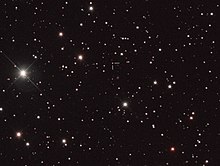A0620-00
| Observation data EpochJ2000EquinoxJ2000 | |
|---|---|
| Constellation | Monoceros |
| Right ascension | 06h22m44.542s[2] |
| Declination | −00° 20′ 44.29″[2] |
| Apparent magnitude(V) | 11.2[3] |
| Characteristics | |
| Evolutionary stage | Black hole+main sequence[4] |
| Spectral type | K2 V[5] |
| Variable type | X-ray nova,Ellipsoidal[6] |
| Astrometry | |
| Radial velocity(Rv) | −5±12[7]km/s |
| Proper motion(μ) | RA:−0.439mas/yr[2] Dec.:−5.138mas/yr[2] |
| Parallax(π) | 0.6969 ± 0.1168mas[2] |
| Distance | approx. 4,700ly (approx. 1,400pc) |
| Orbit | |
| Period(P) | 7.75234 ± 0.00010[7]hr |
| Inclination(i) | 50.98 ± 0.87[4]° |
| Periastronepoch(T) | JD 2446082.7481 ± 0.0008[7] |
| Semi-amplitude(K1) (primary) | 457 ± 8[7]km/s |
| Details | |
| Black hole | |
| Mass | 5.86±1.24[8]M☉ |
| Star | |
| Mass | 0.34±0.03[8]M☉ |
| Radius | 1.057[9]R☉ |
| Luminosity | 0.44[9]L☉ |
| Surface gravity(logg) | 5.0[5]cgs |
| Temperature | 5,000[5]K |
| Metallicity[Fe/H] | 0.0[5]dex |
| Rotational velocity(vsini) | 83.8±1.9[5]km/s |
| Other designations | |
| Database references | |
| SIMBAD | data |
A0620-00(abbreviated from1A 0620-00) is abinary starsystem in theconstellationofMonoceros,with anapparent magnitudeof 11.2.
A0620-00 consists of two objects. The first object is aK-type main-sequence star.[4][5]The second object cannot be seen, but based on its calculated mass of about6M☉,[8][4]it is too massive to be aneutron starand must therefore be a stellar-massblack hole.[7]The two objects orbit each other every 7.75 hours.[7]At a distance of roughly 3,300light-years(1,000parsecs) away, the black hole of A0620-00 would be one of thenearest known black holesto theSolar System,closer thanGRO J1655-40.[10]

A0620-00 has undergone twoX-rayoutbreaks. The first one was in 1917.[11]The second burst, in 1975, was detected by theAriel 5satellite.[12]During that time, A0620-00 was the brightest X-ray point source.[7]It is now classified as anX-ray nova.[7]Its black hole nature was determined in 1986.[7]
The black hole in A0620-00 pulls matter from the K-type star into anaccretion disk.[4]The accretion disk emits significant amounts of visible light and X-rays. Because the K-type star has been pulled into anellipsoidalshape, the amount of surface area visible, and thus the apparent brightness, changes from the Earth's perspective. A0620-00 also bears thevariable star designationV616 Monocerotis.[6]
Stephen Hawking memorial broadcast[edit]
On 15 June 2018, a signal was transmitted from theEuropean Space Agencybig radio antenna atCebreros Station(77 kilometers west of Madrid, Spain), in memory ofStephen Hawking,who died on 14 March 2018, and his work on the physics of black holes. The broadcast will travel the 3,457-light-year distance at thespeed of lightand will arrive in the year 5475; this will be the first-ever human interaction with a currently known black hole.[13]1A 0620-00 was chosen for this broadcast as it was the closest known black hole to Earth at the time.[14] The message was one of peace and hope according to his family.
References[edit]
- ^van Grunsven, Theo F. J.; Jonker, Peter G.; Verbunt, Frank W. M.; Robinson, Edward L. (December 2017)."The mass of the black hole in 1A 0620–00, revisiting the ellipsoidal light curve modelling".Monthly Notices of the Royal Astronomical Society.472(2): 1907–1914.arXiv:1708.08209.Bibcode:2017MNRAS.472.1907V.doi:10.1093/mnras/stx2071.
- ^abcdBrown, A. G. A.;et al. (Gaia collaboration) (2021)."GaiaEarly Data Release 3: Summary of the contents and survey properties ".Astronomy & Astrophysics.649:A1.arXiv:2012.01533.Bibcode:2021A&A...649A...1G.doi:10.1051/0004-6361/202039657.S2CID227254300.(Erratum:doi:10.1051/0004-6361/202039657e).Gaia EDR3 record for this sourceatVizieR.
- ^ab"1A 0620-00".SIMBAD.Centre de données astronomiques de Strasbourg.Retrieved26 August2017.
- ^abcdeCantrell, Andrew G.; Bailyn, Charles D.; Orosz, Jerome A.; McClintock, Jeffrey E.; Remillard, Ronald A.; Froning, Cynthia S.; Neilsen, Joseph; Gelino, Dawn M.; Gou, Lijun (2010). "The Inclination of the Soft X-Ray Transient A0620-00 and the Mass of its Black Hole".The Astrophysical Journal.710(2): 1127–1141.arXiv:1001.0261.Bibcode:2010ApJ...710.1127C.doi:10.1088/0004-637X/710/2/1127.S2CID33906909.
- ^abcdefZheng, Wan-Min; Wu, Qiaoya; Wu, Jianfeng; Wang, Song; Sun, Mouyuan; Guo, Jing; Liu, Junhui; Yi, Tuan; Zhang, Zhi-Xiang; Gu, Wei-Min; Wang, Junfeng; Gou, Lijun; Liu, Jifeng; Callanan, Paul J.; Ho, Luis C.; Longa-Peña, Penélope; Orosz, Jerome A.; Reynolds, Mark T. (2022), "The Disk Veiling Effect of the Black Hole Low-mass X-Ray Binary A0620-00",The Astrophysical Journal,925(1): 83,arXiv:2112.07842,Bibcode:2022ApJ...925...83Z,doi:10.3847/1538-4357/ac4332,S2CID245144462
- ^abSamus, N. N.; Durlevich, O. V.; et al. (2009). "VizieR Online Data Catalog: General Catalogue of Variable Stars (Samus+ 2007-2013)".VizieR On-line Data Catalog: B/GCVS. Originally Published in: 2009yCat....102025S.1.Bibcode:2009yCat....102025S.
- ^abcdefghiMcClintock, J. E.; Remillard, R. A. (1986)."The black hole binary A0620-00".Astrophysical Journal.308:110–122.Bibcode:1986ApJ...308..110M.doi:10.1086/164482.
- ^abcVan Grunsven, Theo F. J.; Jonker, Peter G.; Verbunt, Frank W. M.; Robinson, Edward L. (2017), "The mass of the black hole in 1A 0620-00, revisiting the ellipsoidal light curve modelling",Monthly Notices of the Royal Astronomical Society,472(2): 1907,arXiv:1708.08209,Bibcode:2017MNRAS.472.1907V,doi:10.1093/mnras/stx2071
- ^abStassun, Keivan G.; et al. (1 October 2019), "The Revised TESS Input Catalog and Candidate Target List",The Astronomical Journal,158(4): 138,arXiv:1905.10694,Bibcode:2019AJ....158..138S,doi:10.3847/1538-3881/ab3467,hdl:1721.1/124721,ISSN0004-6256,S2CID166227927.
- ^Foellmi, Cédric (2009). "What is the closest black hole to the Sun?".New Astronomy.14(8): 674–691.arXiv:0812.4232.Bibcode:2009NewA...14..674F.doi:10.1016/j.newast.2009.04.003.S2CID12843219.
- ^Eachus, L. J.; Wright, E. L.; Liller, W. (1976)."Optical observations of the recurrent nova associated with A0620-00 - 1917-1975".Astrophysical Journal.203:L17–L19.Bibcode:1976ApJ...203L..17E.doi:10.1086/182009.
- ^Elvis, M.; Page, C. G.; Pounds, K. A.; Ricketts, M. J.; Turner, M. J. L. (1975). "Discovery of powerful transient X-ray source A0620-00 with Ariel V Sky Survey Experiment".Nature.257(5528): 656–657.Bibcode:1975Natur.257..656E.doi:10.1038/257656a0.S2CID4160399.
- ^Ghosh, Pallab (15 June 2018)."Prof Hawking: A fitting way to go".BBC.Retrieved20 July2019.
- ^Kelly, Guy; Davies, Gareth (15 June 2018)."Stephen Hawking laid to rest between graves of Sir Isaac Newton and Charles Darwin".The Telegraph.ISSN0307-1235.Retrieved16 June2018.
External links[edit]
- "A0620-00".Black Hole Encyclopedia.StarDate. 12 February 2012. Archived fromthe originalon 1 April 2012.Retrieved24 April2017.

